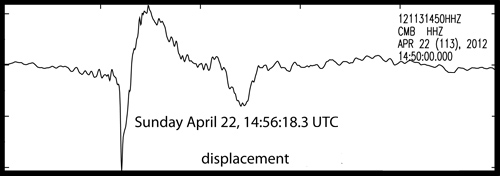Seismo Blog
Meteors on Seismograms
Categories:
April 23, 2012

This seismogram, recorded at Berkeley's seismic station CMB in the Sierra foothills shows the ground movement associated with the sonic boom generated by the meteor. When the sonic boom reached the station, the ground was slightly pushed down by the pressure wave, hence the strong downward movement in the record. After a few seconds, the ground recovered elastically.
The loud boom, which was heard on Sunday morning around 8 am PDT over large areas of eastern California and Nevada, not only rattled the nerves of many who were rudely awakened by the bang. It also set off house and car alarms, and many frightened people called the police. Astronomers quickly determined that a meteor the size of a washing machine had entered the Earth's atmosphere traveling eastward over the West Coast. It may have been part of the annual Lyrid meteor shower, which peaked over the weekend. Similar to a jet flying at supersonic speed, the bolide's travel generated a sonic boom, which was heard over hundreds of square miles on both sides of the Sierra Nevada. However, the meteor was at least ten times faster than the speediest fighter jets.
The loud bang was also registered by many seismometers in the region, among them the sensitive instruments of the Berkeley Digital Seismic Network and its sister networks operated by the University of Nevada in Reno and by the United States Geological Survey.
How can these seismometers, which are designed to notice the slightest movement of the ground, also pick-up sound? In order to find out why, we need to venture a little bit into the physics of waves. Sound waves and seismic waves are essentially the same. Both belong to a group called elastic waves. A sound wave causes a back-and-forth motion of air molecules. When this vibration reaches our ear drums - or the diaphragm of a microphone - it is sensed or recorded as noise. In a similar fashion, an earthquake wave causes particles in the ground to vibrate, albeit with much lower frequencies than audible sound waves.
While most humans can hear sound waves with frequencies between a few hundred and about 15,000 Hertz (vibrations per second), earthquakes cause vibrations in the infrasound range and below. In general, these frequencies are too low to be heard by the human ear. However, seismometers are designed to operate best in the infrasound range down to extremely low frequencies of a few milli-Hertz. Hence, when the sound's frequency is low enough, it can be registered by a seismometer.
There are two reasons why a loud sonic boom like the one heard on Sunday morning leaves distinctive traces on the seismic networks. Firstly, a sonic boom consists of sound waves of a myriad of frequencies, among them some in the infrasound range. These low frequency vibrations can directly trigger a seismometer.
The other reason is the sonic boom's intensity. As an aircraft - or a meteor - jets through the air traveling faster than the speed of sound, it creates a series of sound waves in front of it and behind it. These waves are slower than the jet itself, because they cannot travel faster than the speed of sound in air - or in simple terms: They cannot get away from the aircraft fast enough. As the jet keeps producing more and more of these sound waves, they get stuck, are forced together and eventually, they merge into a single shock wave - the sonic boom. When it hits the ground, it not only dazzles our eardrums. It also generates a pressure pulse on the Earth's surface which leads to a good sized vibration. That is what gets picked-up by the seismometer
Seismic signatures of sonic booms were studied extensively when NASA's Space Shuttle fleet was still flying. Every time a Shuttle landed on the dry lake bed of Edwards Air Force Base east of LA, its sonic boom was registered by the seismometer network in southern California. More on these unique seismograms can be found here. (hra078)
BSL Blogging Team: Who we are
Recent Posts
-
: Alerts for the Whole West Coast
-
: Destruction in the Eastern Aegean Sea
-
: An Explosion in Beirut heard all over the Middle East
View Posts By Location
Categories
- Alaska (3)
- Bay Area (24)
- Buildings (3)
- Calaveras (4)
- California (13)
- Central California (4)
- Chile (4)
- Earthquake Early Warning (10)
- Earthquake Faults and Faulting (44)
- Earthquake Science (3)
- Haiti (3)
- Hayward (12)
- Indonesia (4)
- Induced Seismicity (3)
- Instrumentation (18)
- Italy (6)
- Japan (7)
- MOBB (3)
- Mendocino Triple Junction (5)
- Mexico (7)
- Nepal (3)
- North Korea (5)
- Nuclear Test (5)
- Ocean Bottom Seismometer (3)
- Oklahoma (4)
- Plate Tectonics (18)
- Preparedness, Risks, and Hazards (15)
- Salton Sea (3)
- San Andreas Fault (14)
- Seismic Waves (13)
- Seismograms (4)
- ShakeAlert (3)
- Southern California (5)
- Surface Waves (3)
- Today in Earthquake History (20)
- Volcanoes (4)
- subduction (3)